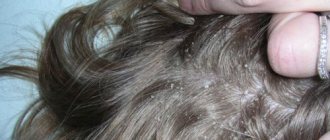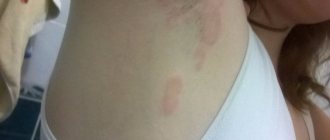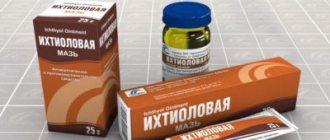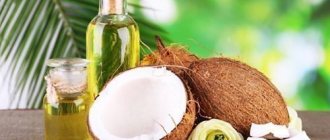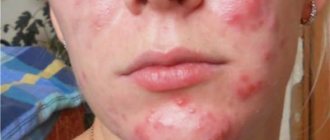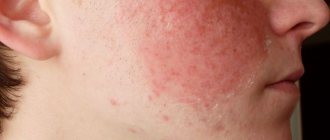Hidradenitis, popularly nicknamed “bitch udder” due to its external signs, is a fairly common disease in humans, which is observed in both women and men of reproductive age. Its occurrence is due to various reasons, the main one of which is pathogenic microflora. Competent and timely treatment will help avoid health-threatening complications.
Causes of hidradenitis
The disease hidradenitis can appear for the following reasons:
- Scratching the skin for itching caused by allergies or other reasons;
- Using various personal hygiene products and cosmetics that can disrupt the pH of the skin;
- Violation of the hormonal state of the body, which leads to increased sweating;
- The presence of hyperhidrosis, which appears due to prolonged exposure to hot climates, heavy physical activity and stress;
- Ingrown hair into the skin after hair removal;
- The occurrence of diaper rash, which may be caused by improper clothing or failure to comply with personal hygiene rules;
- The use of deodorants and talcum powders, which clog the pores on the skin;
- Incorrect structure of the sweat gland ducts.
It is also worth noting that the main cause of bitch udders is impaired functioning of the immune system in the body.
Provoking factors
In addition to the main reasons for the development of bitch udders, there are also a number of factors that can trigger the appearance of the disease:
- Damage to the skin.
- Diaper rash formation.
- The body's immunity is under stress.
- Violation of hygiene standards.
- Having problems with the endocrine system.
- Development of obesity.
- The presence of any bacterial infections.
Physiotherapeutic procedures
Physiotherapy is recognized by medical professionals as one of the effective methods. It is prescribed in the postoperative period if the pathology is severe, long-term and with relapses. But there are other approaches. Some doctors use physiotherapeutic methods in the early stages of the disease. The therapy accelerates wound healing and removes foci of infection.
- Electrophoresis. Using manipulation, the medicine is injected into the affected area. Its concentration enhances the effect of medications.
- Infrared irradiation. Under its action, the blood supply to the tissues of the infected areas improves, and the patient’s condition generally improves.
- Photochemotherapy. Destroys viruses and causes of infection.
- Laser and magnetic. Relieves pain, reduces affected areas in size. The procedures act as analgesics and have a sedative effect. In addition, during these therapies, blood vessels dilate and bacteria are destroyed.
Physiotherapy is contraindicated for patients with diabetes mellitus, blood diseases and the presence of malignant tumors in the body.
The cured type of disease—bough udder—requires continued prevention of the development of skin lesions. Proper hygienic care should always be carried out in the glandular area. It is necessary to remove excess hair, you can cut it short or shave it. They carefully choose cosmetics that cannot cause irritation. All affected areas are protected from dust and sweat. You cannot use ointments or make warm compresses without a prescription. The first sign of the appearance of staphylococcus is a signal to consult a specialist and begin treatment.
mirmedikov.ru
Bitch's udder under the arm
Most often, a bitch udder appears in the armpit area. If you find out the exact cause of the disease, it can be prevented.
The main cause of knotted udders in the armpit is the presence of staphylococci and streptococci. These harmful bacteria initially penetrate the sweat glands and then into the fat cells. After this, inflammation begins in the armpit, which turns into a knotted udder.
One of the types of streptococci - hemolytic - initiates another skin disease - erysipelas of the face.
Symptoms
A pronounced onset of inflammation is not typical for a bitch udder. The disease is gradually increasing in nature.
At the initial stage of the disease, a person develops:
- Severe itching.
- Swelling with painful sensations.
- The swelling has a dense structure.
After some time, the following symptoms begin to develop:
- Increased swelling.
- The swelling acquires a hard structure.
- The pain gets worse.
- The shape of a pear is acquired, and formations appear that look like nipples.
- Skin color becomes burgundy.
At the final stage of development of the bitch udder:
- The inflammation becomes mild.
- From the inflammation, pus with blood is released.
- Body temperature may rise.
- Appearance of weakness.
It may also happen that the disease can become protracted. Most often, a knotted udder is formed on only one side; only in some cases the disease can be bilateral. The duration of the illness can be up to two weeks. If a person has diseases such as diabetes or hyperhidrosis, then the udder may last longer.
If treatment is not started in time, the disease can affect other parts of the body that are responsible for sweating. Very often, a knotted udder can be accompanied by sepsis or an abscess . It is for this reason that treatment should occur after the first symptoms of the disease appear.
Symptoms of the disease
The first to appear is a small nodule that quickly grows. Upon palpation, it can be determined that the formation is located inside the thickness of the skin. As the node or nodes increase, they “move” outward, and the painful aching sensations increase exponentially. The neoplasm acquires a crimson-red, then bluish-violet color. The person experiences accompanying symptoms:
- increase in temperature, in some cases up to 40 degrees;
- general weakness;
- lymph nodes enlarge;
- there is a headache;
- Due to pain, hand movements and crying are quite limited.
Often, after scarring of wounds left after hidradenitis, relapses occur. They appear as multiple ulcers near the place where the formation was for the first time.
Diagnosis of hidradenitis
A bitch udder is quite easy to identify. The specialist must first visually examine the patient and evaluate the location of the inflammatory process, as well as the clinical picture that is characteristic of this disease.
Very often people confuse a knotted udder with a regular boil. However, these diseases have one distinctive feature - necrotic core . Such a rod is typical only for a boil. A bitch's udder can still be very similar to collicative tuberculosis. This disease is characterized by the appearance of severe inflammation of the lymph nodes and the absence of pain.
To visually assess the difference between a boil and a knotted udder, look at the photo of the boil in an article on the topic.
The basis for diagnosing a bitch's udder is a general blood test. If an acceleration of ESR and an increased number of leukocytes are detected in the blood, then this indicates the development of a bitch udder.
If a decision has been made to take antibiotics, then a culture is performed to determine the body’s susceptibility to drugs that are aimed at antibacterial therapy. If the disease has been going on for a long time or appears again, then it is necessary to conduct an immunogram that examines the entire immune system.
Folk remedies
Since a knotted udder occurs when immunity decreases, folk remedies can be used to strengthen it in order to treat and prevent this disease. For these purposes, it is recommended to consume aloe and plantain juice internally, as well as yeast (dry brewer’s yeast is also suitable), sea buckthorn oil and infusions of eleutherococcus and ginseng.
Since hidradenitis can be cured at the initial stage without the use of antibiotics, many people use folk remedies at this stage. For example, to relieve inflammation, it is recommended to wash the area where the compaction occurs with water and salt.
Treatment
Treatment of bitch udders should be strictly individual for each patient. Moreover, treatment should begin only after a complete examination of the person.
You might be interested! How to take sodium thiosulfate to cleanse the body?
Methods for treating bitch udders:
- If the disease is still at the initial stage , then the patient is prescribed ointments with antibiotics. Most often these are tetracycline and erythromycin. The doctor even prescribes alcohol solutions and hydrogen peroxide in combination. In addition, treatment can be based on ultraviolet irradiation.
- If the disease has already developed before the formation of pus , then the formation itself is opened and drained. This procedure is not very complicated, so you should not be afraid of such an operation. After this, the patient is prescribed antibiotics in the form of ciprofloxacin and azitrox.
- If the disease occurs at an active stage , then the formations cannot be wetted. In addition, you should exclude all sweet and spicy foods, as well as alcoholic drinks, from your diet. After the disease is cured, it is necessary to eliminate all factors that could provoke the formation of the disease again.
Ointment
In order to stimulate the purulent contents out of the inflammation, it is smeared with Vishnevsky's liniment or ichthyol ointment. First, you need to cut off all the hair from the site of inflammation, then apply the ointment in a very thin layer over the painful formation. These ointments have stretching properties, so they are also used to quickly form the core of a boil. See a photo of the boil here.
Next, the inflammation must be covered with a sterile bandage. This dressing must be changed at least three times a day or when it becomes dirty. With each replacement, the inflammation must be smeared again.
After the purulent contents are released, the following means must be used:
- antibiotic ointment Levomekol.
- Clindamycin solution lotions.
- Compress from a solution of dimexide and iodine.
- Oflomelid.
In addition, doctors also recommend using retinoic ointment, which includes isotretinoin. This element helps reduce sebum production and reduces sweating activity.
Antibiotics
Treatment must be comprehensive, therefore, in addition to ointments, it is necessary to take antibiotics.
Most often, the following antibiotics are prescribed for the treatment of bitch udders:
- Erythromycin – 4 times a day.
- Tetracycline - once a day.
- Minocycline – 3 times a day.
Physiotherapy
It is very important to note that antibiotics are not taken during physiotherapy procedures.
Physiotherapy aimed at treating bitch udders includes the following procedures:
- Bactericidal technique
- Anti-inflammatory therapy using UHF, SUV irradiation
- Immunostimulating therapy (laser blood irradiation, magnetic therapy, heliotherapy)
- Regenerative technique
Folk remedies
Many doctors say that treating bitch udders with traditional methods is an ineffective method, however, it cannot cause harm to health and can be combined well with drug therapy. In addition, reviews from people indicate that folk remedies can easily combat this disease.
Here are a few folk recipes and methods that can cure a knotted udder:
- One large onion must be cut in half and baked in the oven. When the onion turns golden, it should be applied to the inflammation, secured with a bandage. This compress must be left overnight.
You can apply a paste of plantain leaves to the formation. It is best to secure the mixture with a bandage for several hours.- The cabbage leaf must be beaten well and applied to the site of inflammation.
- The onion is finely chopped and fried in a frying pan with the addition of vegetable oil. You also need to add 3 tablespoons of laundry soap. A compress is made from the resulting mixture and applied to the inflammation overnight.
- The aloe leaf is doused with boiling water and cut lengthwise . The inner part of the leaf must be applied to the inflamed area. This procedure should be repeated 5 times a day.
- It is necessary to prepare a mixture of egg yolks, rendered pork fat, honey and wheat flour. All ingredients are mixed and the resulting mixture is applied to the inflamed areas. After this, the area must be covered with a warm bandage.
Treatment methods
Treatment of hidradenitis is complex. It is almost impossible to cure a knotted udder with one remedy. The doctor will offer a full range of therapeutic actions, describe the rules for taking medications and a course of other measures.
Udder treatment can be represented by the following complex:
- Diet. The duration of proper nutrition will be approximately a three-month period. The doctor will prohibit spicy foods, alcohol, spices, and sweets. The basis of the diet will be foods rich in iron and phosphorus. The patient's diet will not be meager. It is varied and nutritious. Important components of the diet will be apples, nuts, and vegetables (carrots and cabbage). For drinks, rose hip decoction is recommended. It will become both a therapeutic and a prophylactic agent.
- Vitamin sets. Such complexes are among the offers of pharmaceutical organizations. Pharmacies will help you choose the right vitamin kits. You can buy plantain juices, aloe extracts, ginseng tinctures, and echinacea formulations.
- Alcohol lotions. The infection spreads through tissues at a rapid rate. An obstacle will be the cleansing of the glands with alcohol compounds. Any alcohol will do - boric acid or ethyl alcohol, camphor tinctures with essential oils, salicylic aldehyde. It is recommended to treat skin infected with staphylococcus repeatedly. The minimum amount is 3-4 times a day. If possible, more can be done, especially if the infection occurred in the summer. The treatment area should be covered with a plaster or sterile bandage. In addition to alcohol, you can use brilliant green and iodine.
- Medications. The doctor will determine how to stop this inflammatory process. Treatment of hidradenitis is similar to pyoderma therapy: antibiotics, stimulants of the body’s immune activity. Agents with specific actions are often used. This is a vaccination with staphylococcal gamma globulin.
- Surgical methods. They are prescribed when conventional treatments fail. The affected area does not decrease in size. The nodes constantly swell and secrete purulent fluid. The operation goes through stages: first, the ulcers are eliminated, then the entire area affected by inflammation is cut off. The infected fatty area is removed.
- Radical surgical measures. They are resorted to when the pathology returns or relapses. The treatment consists of three parts. Cutting and penetration are carried out until healthy tissue cells are located. The entire infected area is removed. Doctors treat open, unprotected wounds. At the second stage, subcutaneous fat layers are removed. Finally, healthy skin is taken from the patient and the defective areas are covered with it. The radical treatment method is called autodermoplasty in medicine. This method does not take place in one session, more often it involves several operations.
- X-ray therapy. The method is used if others do not give the desired effect. It is based on the destruction of sweat glands, eliminating their functioning and performance.
Prevention
In order to avoid hidradenitis, you must also follow a few simple preventive rules:
- Maintaining cleanliness and personal hygiene.
- Experts strongly recommend not wearing tight clothes. Tight clothing often causes irritation on the skin.
- The armpits should be kept clean at all times.
- If any deodorants or cosmetics cause inflammation on the skin, then it is better not to use it. It is these preventive norms that can prevent the occurrence of the disease.
Complications
Without competent and timely measures, hidradenitis suppurativa is often complicated by lymphadenitis, sepsis or phlegmon. To avoid such consequences, you should not self-medicate.
If the infiltrate cannot be opened within 10–12 days, it is necessary to urgently contact a surgeon, and not wait for further deterioration of health. During the lost time, new foci of hidradenitis will appear, connected to each other by fistulas (channels). Treatment in this case will be long and difficult.
Stages of the disease
Doctors distinguish several stages of the disease depending on the severity:
- At stage 1 of severity, an abscess or several abscesses form on the skin, which do not lead to the formation of fistula tracts, and also do not leave scars.
- With grade 2 severity, 1 or several recurrent nodes form on the skin, forming fistulous tracts or cicatricial changes in the skin.
- At grade 3 of severity, diffuse or near-diffuse branching of abscesses occurs. Also on the skin, interconnected fistulous tracts and purulent nodes can be observed throughout the affected area.
If stage 1 of the disease can be successfully treated with simple conservative treatment (most often), then for stages 2 and 3, therapy should be thoroughly comprehensive and include surgical care.
Other areas of occurrence
Hidradenitis is a suppuration that occurs in the apocrine sweat glands of the body. In many cases, such a defect can be found in the armpit area.
But hidradenitis can occur near the umbilical region, inguinal folds, anus, scrotum, and labia majora.
Treatment of the disease is not easy, but it can be cured. Today there are a large number of methods and methods of struggle. Among them: therapeutic, as well as treatment with medications and medications, it is definitely possible to use traditional methods of treatment, and in severe cases, surgical intervention is indicated.
